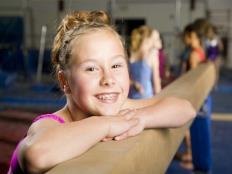It takes some time to learn a new sport, and gymnastics is no different. We all know flips, cartwheels and handstands, but what about layouts, wolf jumps and the Olympic order? Before your child puts on his or her leotard for the first time, look over these terms and phrases every gymnast (and their parents) should know.
A
All Around: When a gymnast competes on all four events (or all six for boys), they compete in the all around. An all around score is the total of all event totals.
Artistic Gymnastics: The most common type of gymnastics, combining dance, tumbling, flexibility and balance to perform on each of the apparatus. This gymnastics discipline is the type you see on TV during the Olympics.
B
Balance Beam: An apparatus that involves a long piece of wood that is four inches wide and 16.5 feet long. While it can be raised or lowered, the standard height of a beam is four feet. Only girls compete on this event, but recreational classes often teach boys to use the beam to practice balance and coordination.
Blind Landing: When a gymnast performs a skill and doesn't see the ground before he or she lands. Skills that are blind landings include front flips, back half and one and a half twists and front full twists—essentially where the gymnast takes off facing one direction and lands facing the same direction.
C
Chalk: A substance—typically magnesium carbonate—used to help gain traction on an event. Gymnasts most often use chalk on the bar events to help get a better grip on the equipment or in general to help reduce slippage from sweat.
Choreography: The movements, expressions and dance that make up a routine.
Code of Points: The rules and regulations of the sport. The code—or COP—outlines skill values, deductions and requirements for routines.
D
Dismount: The skill used to get off the apparatus, or, on floor, the last tumbling pass in a routine.
F
Foam Pit: A large hole in the ground (or in some cases, above ground), filled with foam pieces, most commonly in the form of square blocks. Pits are used to help gymnasts train hard skills into a softer, safer environment before introducing that element to a harder landing surface.
Floor Exercise: An apparatus that involves a large surface 40 feet by 40 feet, most often consisting of springs, ply wood, foam and carpet. Both boys and girls perform on this event. However, girls' routines consist of a routine to music involving dance and tumbling, while boys only concentrate on tumbling, strength and flexibility.
G

Grips: The leather guards gymnasts wear on their hands on the uneven bars, still rings and high bar. All grips consist of a long leather strip covering the palm of the hand with finger holes and a dowel on the inside near the holes. They also either have a strap that Velcros and/or buckles around the wrist to keep them on. Uneven bars grips have two holes, one for your middle finger and one for your ring finger. High bar grips have three holes, one for your pointer finger, one for your middle finger and one for your ring finger, as well as no dowel. Rings grips are nearly identical to uneven bars grips but have a larger dowel.
H
Horizontal Bar: An apparatus involving a thin metal bar high off the ground that easily gives and bends with the weight of the gymnast using it. Only boys compete on high bar.
- 1
- of
- 3








Discuss This Article